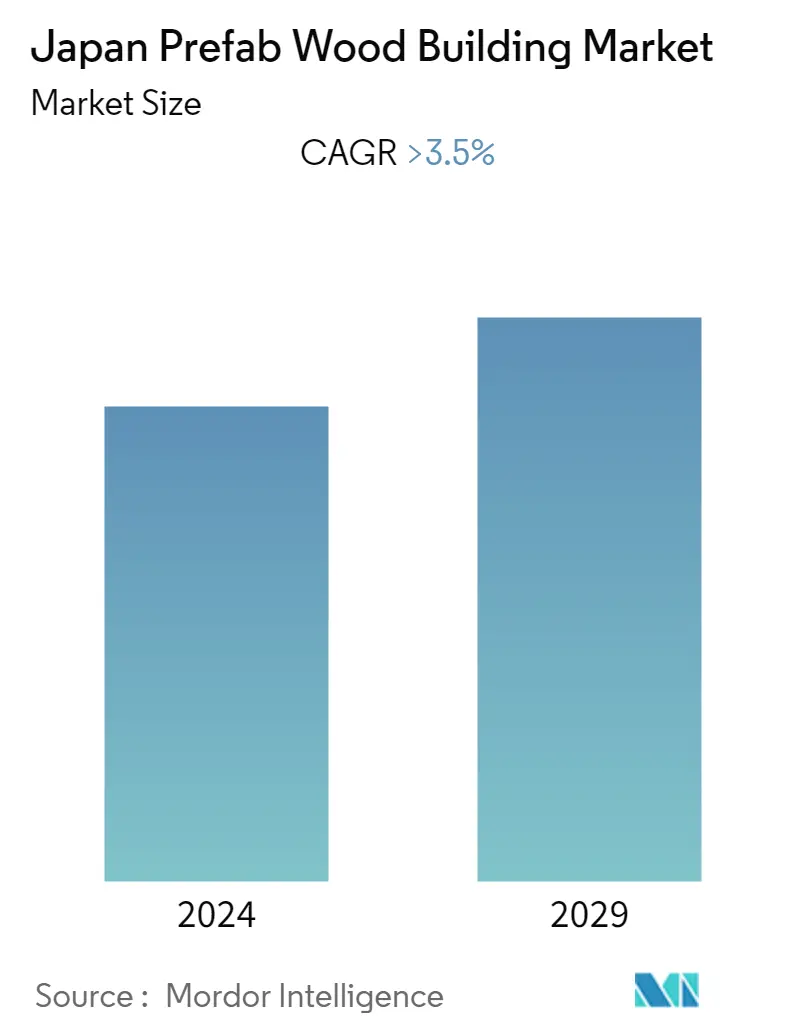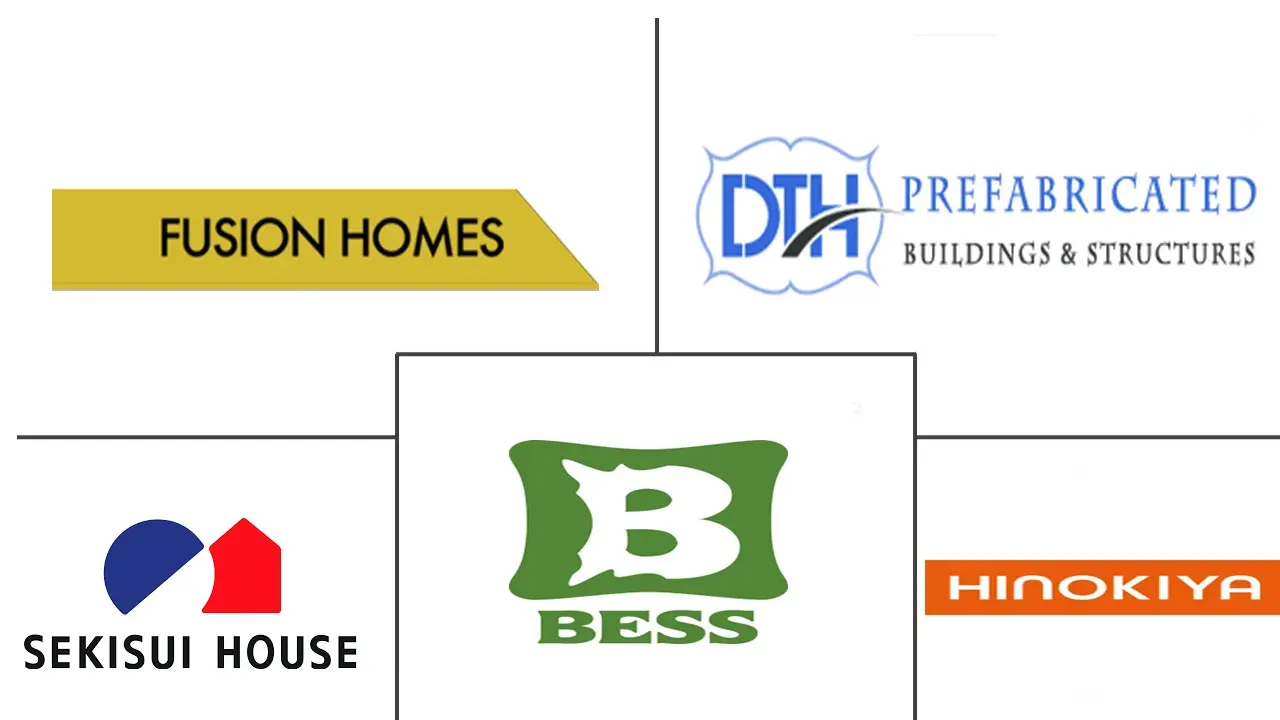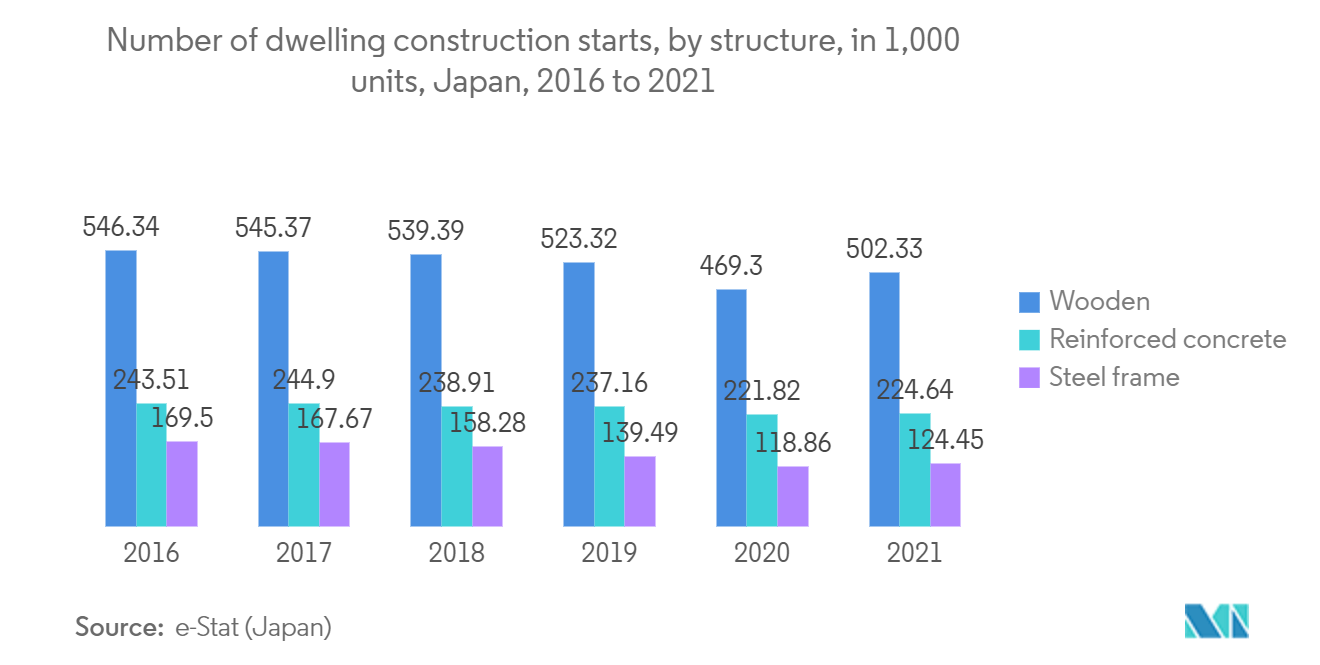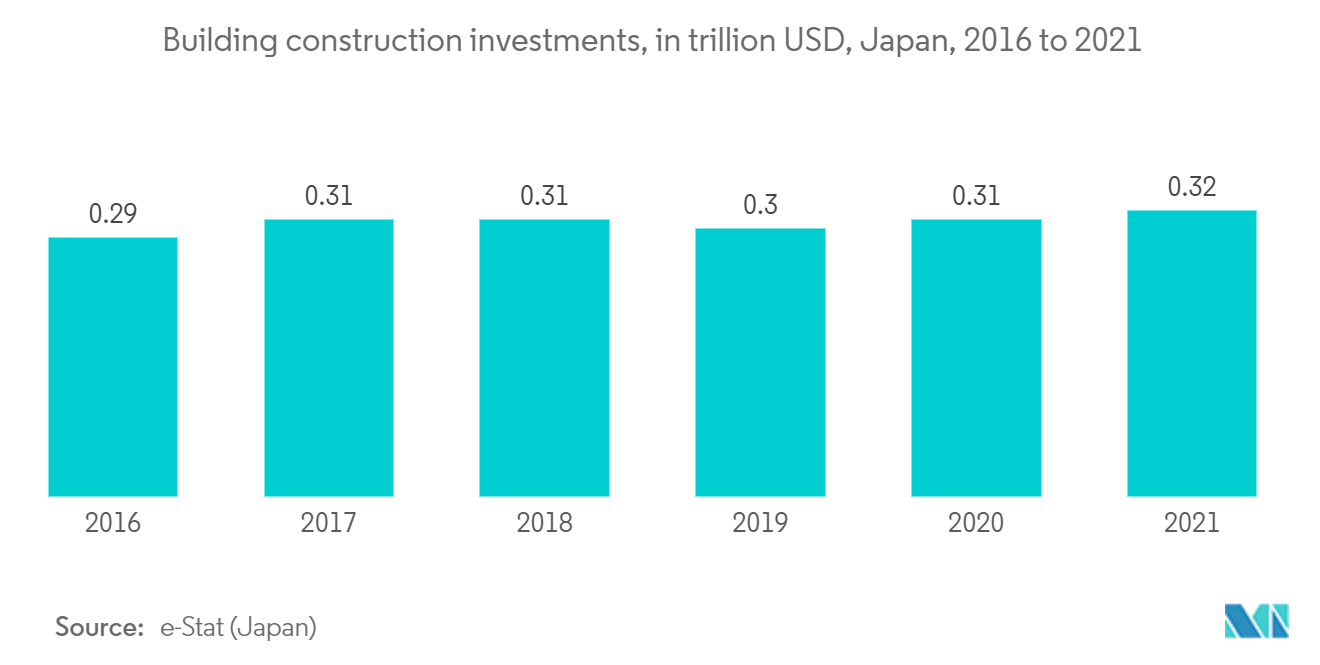Japan Prefab Wood Building Market Size

| Study Period | 2020 - 2029 |
| Base Year For Estimation | 2023 |
| Forecast Data Period | 2024 - 2029 |
| Historical Data Period | 2020 - 2022 |
| CAGR | 3.50 % |
| Market Concentration | Medium |
Major Players
*Disclaimer: Major Players sorted in no particular order |
Japan Prefab Wood Building Market Analysis
Japan Prefab Wood Building Market is expected to register a CAGR of over 3.5% during the forecast period of 2023-2028.
- With efficient manufacturing methods, focused marketing tactics and consumer engagement, and high-quality designs that offer diversity and flexibility at accessible rates, Japan's prefabricated-housing business is a world leader in innovation. Clients may personalize their homes with standardized components using a completely automated system. Unlike the popular Western impression of prefabrication, factory-manufactured houses are seen as better than conventionally constructed ones in Japan.
- The broad system for mass customisation, with a high level of user input throughout the process, is a key element of Japanese prefab housing. Manufacturers employ a modular production strategy, focusing on a custom design for each unit while mass-producing a range of housing components for clients to pick from. This strategy is crucial for meeting the different needs of homebuyer demographics while also reducing costs through mass manufacturing and economies of scale.
- Traditional wooden houses built by small builders are rarely in direct competition with prefabricated houses built by major manufacturers, although there is strong competition among buildings built by huge corporations using any building technique.
Japan Prefab Wood Building Market Trends
This section covers the major market trends shaping the Japan Prefab Wood Building Market according to our research experts:
Wooden Structures are Becoming More Popular in Japan
Mid-rise structures made of wood are becoming more common in Japan. On October 1, 2021, a change to the Public Structures Wood Use Promotion Act will go into effect, increasing the use of domestic forest plantings created after WWII in both public and privately produced buildings. Mitsui Home is constructing its first wood-frame rental apartment complex in Inagi City, Tokyo. The first level of the five-story structure will be reinforced concrete, with two-by-four timber construction on floors 2 and 5. The building method is believed to be equivalent to reinforced concrete in terms of soundproofing, fireproofing, and seismic protection. Construction costs for the developer are around 10 ~ 20% lower than concrete, partly due to the fact that they were able to secure the wood materials prior to the current Wood Shock.
Nomura Real Estate Development has begun sales on a 14-story wood-frame hybrid apartment building in Tokyo's Ochanomizu neighborhood. This is Japan's first wood-frame hybrid condominium-style structure with more than ten floors. Structural features, such as pillars, are manufactured from locally obtained wood. Floors 2-11 were built with laminated veneer lumber (LVL) and reinforced concrete walls, while floors 12-14 were built with cross-laminated timber.

Government's Engagement in UK-Japan Prefab Relations Driving the Market
The comparison between the United Kingdom and Japan is quite offensive. They are so dissimilar, yet they also have so many commonalities. Housing industrialization is one among them. The current efforts to push industrialized processes in UK housing practice have not provided housebuyers with the benefits felt in Japan - production consistency and efficiency, price certainty, high customizability, the inclusion of energy-efficient options, and, most importantly, a customer-oriented business.
In September 2021, Sekisui, a Japanese modular housing company, invested GBP 18.5 million (USD 22.82 Million) in its UK branch. The Japanese builder's UK subsidiary formally entered the UK market in 2019 when it acquired a 35% investment in Urban Splash House Holdings, a modular housebuilding firm founded with developer Urban Splash and Homes England. Also, Daiwa House, located in Japan, established a UK subsidiary in February 2021 and is in negotiations with the Welsh government about establishing a plant.
Japan's industrialization of homes has been consistent and continues to increase their production methods, all based on heavy industry; whereas the UK is re-thinking compact industrialised procedures in an attempt to catch up with the standards and quality witnessed in other locations such as Japan.

Japan Prefab Wood Building Industry Overview
The Japan Prefab Wood Building Market is semi-consolidated in nature, with some players holding a fairly significant market share, to affect the market dynamics individually. To improve their market position, companies the market is releasing new technology, expand their operations, or engaging in strategic mergers and acquisitions. Major prefab manufacturers, such as Panasonic Homes and Toyota Home are entering the wooden housing business, while local power builders and construction companies are gaining power.
Some of the major players are BESS Wooden Homes, DTH Prefab, Fusion Homes Hakuba, Sekisui House and Hinokiya Group.
Japan Prefab Wood Building Market Leaders
-
BESS Wooden Homes
-
DTH Prefab
-
Fusion Homes Hakuba
-
Sekisui House
-
Hinokiya Group
*Disclaimer: Major Players sorted in no particular order

Japan Prefab Wood Building Market News
December, 2022: As part of its bid to sell wooden houses across the country, Sekisui House has bought three housing manufacturers in the western and southern areas of the United States. Sekisui House joined the British market in 2019, however, the company struggled during the COVID-19 epidemic. Sekisui House's investment in a British firm was liquidated this year.
December, 2021: Misawa Home has announced the commencement of sales for its Belle Lead SkipHigh 2-worklabo, a three-story version of their multifamily rental housing product. The building construction technique employs a wood panel bonding method (in Japanese), which is a variation on wood frame construction that addresses the problem of thermal insulation loss in Japanese wooden constructions.
Japan Prefab Wood Building Market Report - Table of Contents
1. INTRODUCTION
- 1.1 Study Deliverables
- 1.2 Study Assumptions
- 1.3 Scope of the Study
2. RESEARCH METHODOLOGY
3. EXECUTIVE SUMMARY
4. MARKET INSIGHTS AND DYNAMICS
- 4.1 Market Overview
- 4.2 Market Drivers
- 4.3 Market Restraints
- 4.4 Value Chain / Supply Chain Analysis
-
4.5 Industry Attractiveness - Porter's Five Force Analysis
- 4.5.1 Threat of New Entrants
- 4.5.2 Bargaining Power of Buyers/Consumers
- 4.5.3 Bargaining Power of Suppliers
- 4.5.4 Threat of Substitute Products
- 4.5.5 Intensity of Competitive Rivalry
- 4.6 Government Regulations and Initiatives
- 4.7 Technological Trends
- 4.8 Brief on Different Structures Used in the Prefabricated Buildings Industry
- 4.9 Cost Structure Analysis of the Prefabricated Buildings Industry
- 4.10 Impact of COVID-19 on the Market
5. MARKET SEGMENTATION
-
5.1 By Panel Systems
- 5.1.1 Cross-laminated timber (CLT) panels
- 5.1.2 Nail-laminated timber (NLT) panels
- 5.1.3 Dowel-laminated timber (DLT) panels
- 5.1.4 Glue-laminated timber (GLT) columns and beams
-
5.2 By Application
- 5.2.1 Residential
- 5.2.2 Commercial
- 5.2.3 Other Applications ( Industrial, Institutional, and Infrastructure)
6. COMPETITIVE LANDSCAPE
- 6.1 Market Concentration Overview
-
6.2 Company Profiles
- 6.2.1 BESS Wooden Homes
- 6.2.2 DTH Prefab
- 6.2.3 Fusion Homes Hakuba
- 6.2.4 Sekisui House
- 6.2.5 Hinokiya Group
- 6.2.6 Panasonic Homes
- 6.2.7 Daiwa House Industry Co.
- 6.2.8 Toyota Housing Corporation
- 6.2.9 Mitsui Home
- 6.2.10 Asahi Kasei Homes Corp.*
- *List Not Exhaustive
7. MARKET OPPORTUNITIES AND FUTURE TRENDS
8. APPENDIX
- 8.1 Macroeconomic Indicators (GDP Distribution, by Activity)
- 8.2 External Trade Statistics - Exports and Imports, by Product
- 8.3 Insights into Key Export Destinations and Import Origin Countries
Japan Prefab Wood Building Industry Segmentation
Prefabricated wood construction kits, similar to life-sized Legos, are constructed out of prefabricated components that are supplied and installed on-site. This is most commonly accomplished by the use of prefabricated panels that may create complete portions of a building, such as roofing components or structure (ceiling, decking, and beams), building structure (wall panels, beams, columns, and shear paneling), and even glazing packages.
The market is segmented By Panels (Cross-laminated timber (CLT) panels, Nail-laminated timber (NLT) panels, Dowel-laminated timber (DLT) panels, and Glue-laminated timber (GLT) columns and beams), and By Application (Residential, Commercial and Other Applications ( Industrial, Institutional, and Infrastructure)).
The report offers market size and forecasts for Japan Prefab Wood Building Market in value (USD Billion) for all the above segments. The report also covers the impact of COVID-19 on the market.
| By Panel Systems | Cross-laminated timber (CLT) panels |
| Nail-laminated timber (NLT) panels | |
| Dowel-laminated timber (DLT) panels | |
| Glue-laminated timber (GLT) columns and beams | |
| By Application | Residential |
| Commercial | |
| Other Applications ( Industrial, Institutional, and Infrastructure) |
Japan Prefab Wood Building Market Research FAQs
What is the current Japan Prefab Wood Building Market size?
The Japan Prefab Wood Building Market is projected to register a CAGR of greater than 3.5% during the forecast period (2024-2029)
Who are the key players in Japan Prefab Wood Building Market?
BESS Wooden Homes, DTH Prefab, Fusion Homes Hakuba, Sekisui House and Hinokiya Group are the major companies operating in the Japan Prefab Wood Building Market.
What years does this Japan Prefab Wood Building Market cover?
The report covers the Japan Prefab Wood Building Market historical market size for years: 2020, 2021, 2022 and 2023. The report also forecasts the Japan Prefab Wood Building Market size for years: 2024, 2025, 2026, 2027, 2028 and 2029.
Japan Prefab Wood Building Industry Report
Statistics for the 2024 Japan Prefab Wood Building market share, size and revenue growth rate, created by Mordor Intelligence™ Industry Reports. Japan Prefab Wood Building analysis includes a market forecast outlook to 2029 and historical overview. Get a sample of this industry analysis as a free report PDF download.



